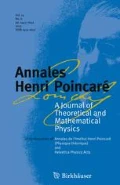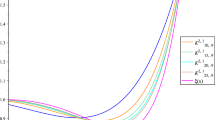Abstract
We prove the Schrödinger operator with infinitely many point interactions in \(\mathbb {R}^d\)\((d=1,2,3)\) is self-adjoint if the support \(\Gamma \) of the interactions is decomposed into infinitely many bounded subsets \(\{\Gamma _j\}_j\) such that \(\inf _{j\not =k}\mathop {\mathrm{dist}}\nolimits (\Gamma _j,\Gamma _k)>0\). Using this fact, we prove the self-adjointness of the Schrödinger operator with point interactions on a random perturbation of a lattice or on the Poisson configuration. We also determine the spectrum of the Schrödinger operators with random point interactions of Poisson–Anderson type.











Similar content being viewed by others
References
Abramowitz, M., Stegun, I.A.: Handbook of mathematical functions with formulas, graphs, and mathematical tables. National Bureau of Standards Applied Mathematics Series, vol. 55. U.S. Government Printing Office, Washington, DC (1964)
Albeverio, S., Gesztesy, F., Høegh-Krohn, R., Holden, H.: Solvable models in quantum mechanics, 2nd edn. With an appendix by Pavel Exner, AMS Chelsea Publishing, Providence, RI (2005)
Albeverio, S., Høegh-Krohn, R., Kirsch, W., Martinelli, F.: The spectrum of the three-dimensional Kronig–Penney model with random point defects. Adv. Appl. Math. 3, 435–440 (1982)
Agmon, S.: Lectures on Elliptic Boundary Value Problems. Van Nostrand Reinhold Inc., New York (1965)
Ando, K., Iwatsuka, A., Kaminaga, M., Nakano, F.: The spectrum of Schrödinger Operators with Poisson type random potential. Ann. Henri Poincaré 7, 145–160 (2006)
Berezin, F.A., Faddeev, L.D.: A remark on Schrödinger’s equation with a singular potential. Soviet Math. Dokl. 2, 372–375 (1961)
Bethe, H., Peierls, R.: Quantum theory of the diplon. Proc. R. Soc. 148A, 146–156 (1935)
Boutet de Monvel, A., Grinshpun, V.: Exponential localization for multi-dimensional Schrödinger operator with random point potential. Rev. Math. Phys. 9(4), 425–451 (1997)
Brüning, J., Geyler, V., Pankrashkin, K.: Spectra of self-adjoint extensions and applications to solvable Schrödinger operators. Rev. Math. Phys. 20(01), 1–70 (2008)
Christ, C.S., Stolz, G.: Spectral theory of one-dimensional Schrödinger operators with point interactions. J. Math. Anal. Appl. 184, 491–516 (1994)
Delyon, F., Simon, B., Souillard, B.: From power pure point to continuous spectrum in disordered systems. Ann. Inst. Henri Poincaré 42(3), 283–309 (1985)
Dorlas, T.C., Macris, N., Pulé, J.V.: Characterization of the spectrum of the Landau Hamiltonian with delta impurities. Commun. Math. Phys. 204, 367–396 (1999)
Drabkin, M., Kirsch, W., Schulz-Baldes, H.: Transport in the random Kronig–Penney model. J. Math. Phys. 53, 122109 (2012)
Geĭler, V.A.: The two-dimensional Schrödinger operator with a uniform magnetic field, and its perturbation by periodic zero-range potentials. St. Petersburg Math. J. 3(3), 489–532 (1992)
Geĭler, V.A., Margulis, V.A., Chuchaev, I.I.: Potentials of zero radius and Carleman operators. Sib. Math. J. 36(4), 714–726 (1995)
Grossmann, A., Høegh-Krohn, R., Mebkhout, M.: The one particle theory of periodic point interactions. Commun. Math. Phys. 77, 87–110 (1980)
Hislop, P.D., Kirsch, W., Krishna, M.: Spectral and dynamical properties of random models with nonlocal and singular interactions. Math. Nachrichten 278, 627–664 (2005)
Kaminaga, M., Mine, T.: Upper bound for the Bethe–Sommerfeld threshold and the spectrum of the Poisson random hamiltonian in two dimensions. Ann. Henri Poincaré 14, 37–62 (2013)
Kirsch, W., Martinelli, F.: On the spectrum of Schrödinger operators with a random potential. Commun. Math. Phys. 85, 329–350 (1982)
Kostenko, A.S., Malamud, M.M.: 1-D Schrödinger operators with local point interactions on a discrete set. J. Differ. Equ. 249(2), 253–304 (2010)
Kronig, R.de L., Penney, W.G.: Quantum mechanics of electrons in crystal lattices. Proc. R. Soc. 130A, 499–513 (1931)
Malamud, M.M., Schmüdgen, K.: Spectral theory of Schrödinger operators with infinitely many point interactions and radial positive definite functions. J. Funct. Anal. 263(10), 3144–3194 (2012)
Meester, R., Roy, R.: Continuum Percolation, Cambridge Tracts in Mathematics, vol. 119. Cambridge University Press, Cambridge (1996)
Minami, N.: Schrödinger operator with potential which is the derivative of a temporally homogeneous Lévy process. In: Watanabe, S., Prokhorov, J.V. (eds.) Probability Theory and Mathematical Statistics, Lecture Notes in Mathematics, vol. 1299. Springer, Berlin, Heidelberg (1988)
Pastur, L., Figotin, A.: Spectra of Random and Almost Periodic Operators. Springer, Berlin (1992)
Reed, M., Simon, B.: Methods of Modern Mathematical Physics. II. Fourier Analysis, Self-Adjointness. Academic Press, New York (1975)
Reiss, R.-D.: A Course on Point Processes. Springer Series in Statistics. Springer, New York (1993)
Thomas, L.H.: The interaction between a neutron and a proton and the structure of \(H^3\). Phys. Rev. 47, 903–909 (1935)
Acknowledgements
The work of T. M. is partially supported by JSPS KAKENHI Grant No. JP18K03329. The work of F. N. is partially supported by JSPS KAKENHI Grant No. JP26400145.
Author information
Authors and Affiliations
Corresponding author
Additional information
Communicated by Alain Joye.
Publisher's Note
Springer Nature remains neutral with regard to jurisdictional claims in published maps and institutional affiliations.
Appendix
Appendix
1.1 Renormalization Procedure for Point Interactions
For readers’ convenience, we quote a result about the renormalization procedure (1)

in the case \(d=3\) and \(\Gamma =O:=\{0\}\) ([2, Theorem I-1.2.5]).
Theorem 23
([2]). Let \(d=3\). Let V be a real-valued function on \(\mathbb {R}^3\) belonging to Rollnik class (i.e., \(\iint _{\mathbb {R}^3\times \mathbb {R}^3}|V(x)||V(x')||x-x'|^{-2}\mathrm{d}x\mathrm{d}x'<\infty \)), and \((1+|\cdot |)V\in L^1(\mathbb {R}^3)\). Let \(\lambda (\epsilon )=\epsilon \mu (\epsilon )\), where \(\mu (\epsilon )\) is real analytic near \(\epsilon =0\), \(\mu (0)=1\) and \(\mu '(0)\not =0\). Let \(G_0=(-\Delta )^{-1}\), defined as an integral operator with integral kernel \(1/(4\pi |x-x'|)\). If two functions \(\phi \in L^2(\mathbb {R}^3)\) and \(\psi \in L^2_\mathrm{loc}(\mathbb {R}^3){\setminus } L^2(\mathbb {R}^3)\) satisfy
where \(\mathop {\mathrm{sgn}}\nolimits z= z/|z|\) (\(z\not =0\)) and \(\mathop {\mathrm{sgn}}\nolimits 0 =1\), then \(\psi \) is called a zero-energy resonance for \(-\Delta +V\).
- (i)
If a zero-energy resonance for \(-\Delta +V\) exists, then the norm resolvent limit of \(H_{\epsilon }\) in (1) coincides with \(H_{O,\alpha }\), \(\alpha =(\alpha _0)\), for some \(\alpha _0\in \mathbb {R}\).
- (ii)
If no zero-energy resonance for \(-\Delta +V\) exists, then the norm resolvent limit of \(H_{\epsilon }\) in (1) coincides with the free Laplacian \(H_0\).
It is easy to see that \(\psi \) satisfies the equation \((-\Delta +V)\psi =0\). In the case (i), an explicit formula for \(\alpha _0\) is given in [2, Theorem I-1.2.5]. If \(-\Delta +V\) has simple zero-energy resonance \(\psi \) and no zero-energy eigenfunction, it is given as
Thus, \(\alpha _0\) appears in the coefficient of \(\lambda (\epsilon )\) as \(\lambda (\epsilon )=\epsilon - C\alpha _0 \epsilon ^2 + O(\epsilon ^3)\). It is known that if V is nonnegative, then there is no zero-energy resonance for \(-\Delta +V\). So, the occurrence of the case (i) requires V to have negative part.
A similar result is obtained also in the case \(d=2\), but \(\alpha _0\) appears in the coefficient of \(\lambda (\epsilon )\) in more complicated way (see [2, Theorem I-5.5]).
1.2 Elliptic Inner Regularity Estimate
The following is a special case of the elliptic inner regularity theorem ([4, Theorem 6.3]).
Theorem 24
Let U be an open set in \(\mathbb {R}^d\) and \(u\in L^2(U)\). Assume that there exists a positive constant M such that
holds for every \(\phi \in C_0^\infty (U)\). Then, \(u\in H^2_\mathrm{loc}(U)\). Moreover, for any open set V such that \(\overline{V}\) is a compact subset of U, there exists a positive constant C dependent only on U and V such that
where M is the constant in (31).
From Theorem 24, we have the following corollary useful for our purpose.
Corollary 25
Let U, V be open sets in \(\mathbb {R}^d\) such that \(\overline{V}\subset U\) and
for some positive constant \(\delta \). Let \(u\in L^2(U)\) such that \(\Delta u\in L^2(U)\) in the distributional sense. Then, \(u\in H^2_\mathrm{loc}(U)\), and there exists a constant C dependent only on \(\delta \) and the dimension d such that
Proof
Put \(\epsilon =\delta /(2d)\). For \(x_0\in \mathbb {R}^d\), consider open cubes \(Q=x_0 + (-\epsilon ,\epsilon )^d\) and \(Q'=x_0 + (-\epsilon /2,\epsilon /2)^d\). When \(Q\subset U\), we have
for every \(\phi \in C_0^\infty (Q)\). Then, the assumption of Theorem 24 is satisfied with \(U=Q\), \(V=Q'\), and \(M=\Vert \Delta u\Vert _{L^2(Q)}\), and we have
for some positive constant C dependent only on \(\delta \) and dimension d. We collect all the cubes \(Q'\) such that the center \(x_0\in \epsilon \mathbb {Z}^d\) and \(Q'\cap V \not =\emptyset \). Notice that \(Q\subset U\) for such \(Q'\). Thus, we have by (33)
where we use the fact Q can overlap at most \(2^d\) times. \(\square \)
Rights and permissions
About this article
Cite this article
Kaminaga, M., Mine, T. & Nakano, F. A Self-adjointness Criterion for the Schrödinger Operator with Infinitely Many Point Interactions and Its Application to Random Operators. Ann. Henri Poincaré 21, 405–435 (2020). https://doi.org/10.1007/s00023-019-00869-1
Received:
Accepted:
Published:
Issue Date:
DOI: https://doi.org/10.1007/s00023-019-00869-1




